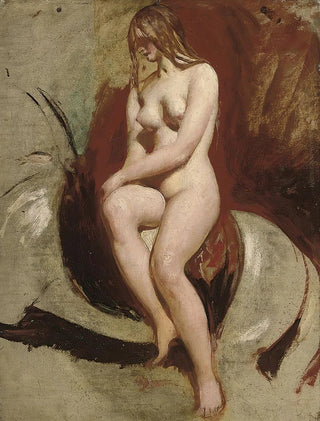Art print | Nude woman sitting - William Etty


View from behind

Frame (optional)
In the world of art, some works transcend the simple frame of painting to become living testimonies of human emotion and beauty. "Nude Woman Sitting" by William Etty is one of those creations that captivate the eye and the mind. This piece, created in the 19th century, reflects the bold vision of the artist and his commitment to the human body as a subject of study and celebration. Etty, often regarded as a pioneer in the depiction of the female nude, manages to blend sensuality with psychological depth, offering a unique perspective on the human condition. In this work, the woman, both vulnerable and strong, embodies an aesthetic ideal that continues to inspire art lovers across the ages.
Style and uniqueness of the work
William Etty's style is distinguished by his daring use of color and light, creating an atmosphere that is both intimate and universal. In "Nude Woman Sitting," warm and rich tones envelop the female figure, emphasizing the curves and contours of her body. The artist focuses on the texture of the skin, hair, and drapery, making each element palpable and alive. This attention to detail, combined with a harmonious composition, allows the piece to breathe and evoke a sense of movement. Etty succeeds in capturing not only the physical beauty of his model but also a deeper essence, that of femininity and sensuality. The woman's posture, both relaxed and contemplative, invites the viewer to reflect on her thoughts and emotions, creating a silent dialogue between the artwork and its observer.
The artist and his influence
William Etty, born in York in 1787, is often regarded as a precursor to the Romantic movement in England. His career, marked by challenges and controversies, demonstrates his dedication to art and the depiction of the human body. Etty was one of the first British artists to fully dedicate himself to painting nudes, challenging the conventions of his time. His innovative approach and distinctive style paved the way for many artists who followed him. He

Matte finish

View from behind

Frame (optional)
In the world of art, some works transcend the simple frame of painting to become living testimonies of human emotion and beauty. "Nude Woman Sitting" by William Etty is one of those creations that captivate the eye and the mind. This piece, created in the 19th century, reflects the bold vision of the artist and his commitment to the human body as a subject of study and celebration. Etty, often regarded as a pioneer in the depiction of the female nude, manages to blend sensuality with psychological depth, offering a unique perspective on the human condition. In this work, the woman, both vulnerable and strong, embodies an aesthetic ideal that continues to inspire art lovers across the ages.
Style and uniqueness of the work
William Etty's style is distinguished by his daring use of color and light, creating an atmosphere that is both intimate and universal. In "Nude Woman Sitting," warm and rich tones envelop the female figure, emphasizing the curves and contours of her body. The artist focuses on the texture of the skin, hair, and drapery, making each element palpable and alive. This attention to detail, combined with a harmonious composition, allows the piece to breathe and evoke a sense of movement. Etty succeeds in capturing not only the physical beauty of his model but also a deeper essence, that of femininity and sensuality. The woman's posture, both relaxed and contemplative, invites the viewer to reflect on her thoughts and emotions, creating a silent dialogue between the artwork and its observer.
The artist and his influence
William Etty, born in York in 1787, is often regarded as a precursor to the Romantic movement in England. His career, marked by challenges and controversies, demonstrates his dedication to art and the depiction of the human body. Etty was one of the first British artists to fully dedicate himself to painting nudes, challenging the conventions of his time. His innovative approach and distinctive style paved the way for many artists who followed him. He






